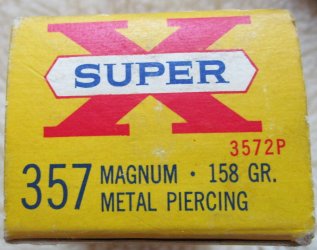You are using an out of date browser. It may not display this or other websites correctly.
You should upgrade or use an alternative browser.
You should upgrade or use an alternative browser.
Remington Kleanbore 357 158gr Metal Point question
- Thread starter moosedog
- Start date
Register to hide this ad
- Joined
- Apr 4, 2006
- Messages
- 19,785
- Reaction score
- 31,585
1934 - 1942. I got this information from the site below. Because 357 magnum was introduced in 1935 it would most likely be after that but before 1942.
 cartridgecollectors.org
cartridgecollectors.org
Dating Remington Cartridge Boxes – International Ammunition Association
 cartridgecollectors.org
cartridgecollectors.org
DWalt
Member
There will also usually be some dating code (lot number), either impressed or ink stamped somewhere on the box, such as"D27S". That can often be deciphered to reveal the month and year of loading. But the nature of those codes will be different for different manufacturers, i.e., Remington used a different coding system than Western.
Last edited:
- Joined
- Aug 9, 2005
- Messages
- 9,218
- Reaction score
- 11,432
I have most of a box of that; it was purchased around 1970. I chronographed a few rounds. It was in the 1,200+ fps range in a 6" barreled revolver. Surely this stuff wouldn't shoot through anything but the thinnest of metals?Here is the Western Super X entry into the 357 metal piercing arena.View attachment 775553
I had a box of the Remington, It would not shoot through an old electric iron which had about 1/4" soft metal plate on the bottom - a follow up shot with a 16 gauge foster slug disentegrated the iron!I have most of a box of that; it was purchased around 1970. I chronographed a few rounds. It was in the 1,200+ fps range in a 6" barreled revolver. Surely this stuff wouldn't shoot through anything but the thinnest of metals?
Roposte
- Joined
- Aug 9, 2005
- Messages
- 9,218
- Reaction score
- 11,432
Shooting through impenetrable barriers they will never have a need to shoot through is very important to some.
bigggbbruce
Member
I shoot tin cans all the time.I have most of a box of that; it was purchased around 1970. I chronographed a few rounds. It was in the 1,200+ fps range in a 6" barreled revolver. Surely this stuff wouldn't shoot through anything but the thinnest of metals?
Reloader Fred
Member
- Joined
- Jun 15, 2009
- Messages
- 179
- Reaction score
- 148
The metal piercing rounds in both .38 Special and .357 Magnum were designed to shoot into cars when they were actually made out of real steel, and had more than a modicum of metal in the doors, etc. The mobsters of the era outgunned the police, who were mostly armed with .38 Special round nose lead bullets, which wouldn't penetrate through car doors. These were designed to alleviate that problem. The one I pulled had a truncated metal nose, and a lead bearing surface, but I don't remember which brand it was, as it was many years ago.
They weren't designed as armor piercing rounds, just metal piercing, as in car doors.
Hope this helps.
Fred
They weren't designed as armor piercing rounds, just metal piercing, as in car doors.
Hope this helps.
Fred
- Joined
- Aug 9, 2005
- Messages
- 9,218
- Reaction score
- 11,432
That was a common tale worthy of dubious Internet credibility long before the Internet.Another explanation I read about years ago is that the .357 with metal point was supposed to crack an engine block thereby disabling the bad guys getaway car.
Last edited:
Similar threads
- Locked
Sold/Withdrawn
Vintage ammo--CHEAP AMMO (DFW area)
- Replies
- 0
- Views
- 187
- Replies
- 0
- Views
- 474


